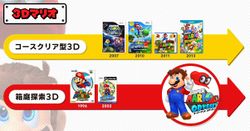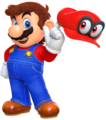Super Mario Odyssey
This article is about an upcoming game. Editors must cite sources for all contributions to this article. Edits that do not follow this standard may be reverted without notice.
Template:Infobox Super Mario Odyssey is an upcoming platform game for the Nintendo Switch set to release Holiday 2017. It is the sixteenth title in the Super Mario series, the seventh original 3D Mario title, the eighth 3D Mario title overall, and the sixth 3D Mario title on a home console after Super Mario 3D World. The game has Mario leaving the Mushroom Kingdom to reach an unknown open world-like setting, like Super Mario 64 and Super Mario Sunshine. This new world has been stated to bear resemblances to the real world[1].
Mario will maintain his moveset from previous 3D titles, including the Long Jump, Roll, Ground Pound, the Triple Jump and the Dive, the last of which hasn't been since Super Mario Sunshine. In addition, he will be wearing a different cap in this game, which has eyes, implying it may be alive. A new mechanic in the game allows Mario to throw this cap as if it was a boomerang, and he can also jump off of the cap in midair like a platform. Judging by posters seen in the announcement trailer, it seems that the game's story will involve, at least in part, Mario preventing a forced marriage of Princess Peach to Bowser.[1]
Confirmed features
Characters
Supporting
- Princess Peach
- Mario's Cap
- A golden lion sculpture Mario can ride on
Villains
- Bowser
- A quartet of rabbit characters in formal clothing
Non-playable characters
- Humans (present in New Donk City)
- Fork creatures in chef attire (present in the Template:Conjecturaltext)
- Green-yellow robots which appear alongside aforementioned fork creatures (present in the Template:Conjecturaltext)
- Skull-headed coco-like creatures in ponchos and sombreros (present in the Template:Conjecturaltext)
- Rabbits (present in the Template:Conjecturaltext)
Enemies
- Goombas wearing hard hats
- Goomba Towers
- Piranha Plants
- Spinies
- Bullet Bills and Bill Blasters
- Hammer Bros that wear chef hats and throw frying pans (present in the Template:Conjecturaltext)
- Flower pots with stretching bramble legs (present in the Template:Conjecturaltext)
- Small purple creatures with star eyes (present in the Template:Conjecturaltext)
- Small tanks that wear top hats and spit bullets
- Sentry Beam- or Ring Burner-like robots
- A robotic caterpillar
Other
- A pink Wingo-like bird in chef attire (present in the Template:Conjecturaltext)
- Yellow, spinning plant-watering machines (present in the Template:Conjecturaltext)
- Moving and stationary taxi cabs
Items and objects
- Purple collectibles
- Coin/coin-like (New Donk City)
- Triangular (Template:Conjecturaltext)
- Screw nut shape (Template:Conjecturaltext)
- Polygonal sphere (Template:Conjecturaltext)
- Boom boxes
- Beanstalks
- Checkpoint Flags
- Coins
- Coin Rings
- Crates
- Doors
- ? Blocks
- P Switches
- Turnips
- Treasure chests
- Warp Pipes
- A globe of an Earth-like planet on Mario's transportation ship
Locations
- New Donk City, a city with many references to the Donkey Kong series
- A cold desert, with several glaciers
- A colorful town inhabited by the skull characters
- Ruins where the golden lion is found
- An area with an upside-down floating pyramid
- A series of midair platforms near a castle building
- A cave filled with glaciers illuminated by blue light where ruins are found as well
- An area with a forest and metallic structures surrounded by mountains and a glassy wall
- A waterfall and a stream
- A circular tower top with flowers where one of the rabbit characters is fought
- An area with platforms moving up and down and Piranha Plants on poison-like puddles
- A bridge made of flowering plants
- A colorful area filled with crystal-like food and produce inhabited by the fork creatures
- Bowser's airship, colored white and purple
Development

As part of the "Treehouse Live" event on January 13, 2017, Shigeru Miyamoto was hosted as a special guest, and interviewed for the Super Mario Odyssey segment.[2] When asked about "coming home" to the Super Mario 64 and Super Mario Sunshine style of gameplay, Miyamoto explained that when he was developing Super Mario 64 with Yoshiaki Koizumi, they realized that the title would be more directed towards the "core gamer", rather than the casual, pick-up-and-go gamer. After Super Mario Sunshine, their focus reshifted to more accessible, casual gamers. This is why they chose to make Super Mario Galaxy.
Then in recent years, we made Super Mario 3D World and even though that's a 3D game, it's a little more accessible to everybody. And so speaking of casual gamers, we have Super Mario Maker out, and we also have Super Mario Run. So when we thought about making a Mario for Switch, we wanted to make it [...] something a little bit more on the core side, that people who like action games can really get into.
Miyamoto discussed how the 3D camera in Super Mario 64 worked very well, as it had the joystick as well as the C buttons to adjust the automatic camera. Super Mario Sunshine had the C stick in order to "control the camera freely", although they received feedback that the camera control was "a little bit difficult". With later 3D titles such as Super Mario Galaxy, the minimal control of the camera also attracted some negative feedback. Miyamoto added that it's "very difficult to find the right balance".
With Super Mario Odyssey, we made sure that the camera controls are really really smooth and easy to use, and the Switch controllers can really serve to that. [We] really made a sandbox-style game that's really easy and feels good to control.
With all the different ideas that Miyamoto received from other, "younger" developers and programmers, some actually worried him about how well Mario would "fit in" to these different worlds, although he was "open minded" to all ideas that were presented. Miyamoto also sought more senior developers and staff teams who had been involved in past 3D Mario titles, such as Yoshiaki Koizumi, in order to really "go back to the roots" of Super Mario Sunshine.
Gallery
- SMO Logo - NA.png
Logo
Artwork of Mario with the hat.
References to other games
- Donkey Kong: The location New Donk City looks to be a throwback to Mario's early origins as Jumpman. There are steel girders that resemble the ones seen in this game, and the taxi cabs have license plates reading "1981-ND", referencing the year Mario and Donkey Kong made their debut. The name New Donk City is also a reference to Donkey Kong himself.
- Donkey Kong Country series: Characters' names from this series appear as street signs all over New Donk City such as Diddy Kong, Cranky Kong, Rambi the Rhino, Expresso the Ostrich, Squawks the Parrot, Dixie Kong, Tiny Kong, and King K. Rool.
References
- ^ a b Nintendo. (January 13, 2017). Super Mario Odyssey - Nintendo Switch Presentation 2017 Trailer. Youtube. Retrieved January 13, 2017.
- ^ NinEverything. (January 13, 2017). Miyamoto on Super Mario Odyssey - Nintendo Treehouse Live with Nintendo Switch. YouTube. Retrieved January 15, 2017.



